Comments and Feedback from making xylitol hard candies
Feedback
I get quite a few emails about xylitol candies and lozenges, most are from people who didn't read something thoroughly or didn't quite understand what I meant. In those instances I've tweaked the webpages accordingly BUT there are some comments I get frequently enough that I thought I would start posting some responses.
Warning - Apparently the xylitol sticks can be "sharp" and/or difficult to break. I personally have not had any problems and didn't really notice but I've received more than a dozen emails mentioning this so I'm putting this here for now and if I ever get around to updating the webpages I will add a warning where appropriate. For now keep in mind that it appears possible for people with soft skin to cut themselves and those with weaker hands may want to use some type of tool to snap off bite size pieces. Alternatively break away moulds are a good option if you have them.
Mug Warmers
{NEW: I added a recommended mug warmer in Equipment. It's under $10 from Amazon and just works!}
This is one of those things where it's impossible for me to try everything that is available. The one I use is an old old oh so very old Dazey Corp. 25W Mug Warmer that I picked up in a thrift store. I actually picked up 5 or 6 and took them in to lab and this is the only one I kept for me.
The procedure I created was tried on a 17W cup warmer that my dad got from Walmart and it works fine and the 25g size was used because that was what worked for it. With my 25W warmer I can do 3 to 4 times the quantity {75g to 100g} though ~80g is the easy limit above that and I need to wrap the glass in foil.
That said the most common problem are people using "new" cup warmers that claim to be 17W but are really only 12W or 13W.
If a mug warmer cannot keep your coffee warm it will not work!
Do NOT even think of using a USB mug warmer !!!
I recommend using a 20 to 25W mug warmer if possible.
Mug Warmer Research
I'm not about to go out and buy every possible mug warmer but I did happen to go by Bed Bath & Beyond and saw two 16W mug warmers on their clearance shelves AND since I had a $5 off coupon I picked them up because I know atleast two people have complained about using this particular device. The other mug warmer I've had complaints about is the Mr.Coffee mug warmer which I read online is only 13W though it claims to be 17W.
An actual 17W outputting mug warmer will work with the siguie protocol as described.
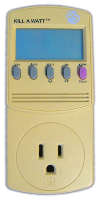
To get a reading of how much power these things use I employed my Kill-a-Watt meter.
These things are incredibly useful and I highly recommend people have one. They are very accurate and a great way to figure out where your homes energy is being consumed. I hook up all new appliances and electronic "stuff" to mine in order to get an understanding of what to expect ... startup spikes, ghost loads, overall consumption over a few days or weeks etc.
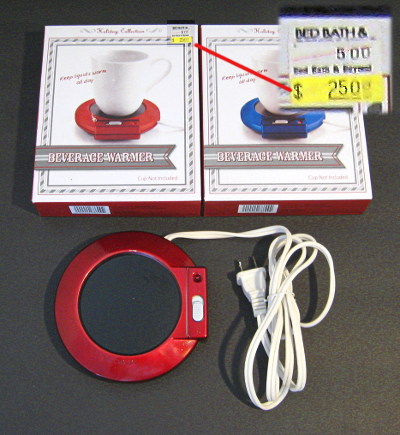
To the right are the two warmers I picked up at Bed Bath & Beyond. Apparently they typically sell for $5 which makes them one of the cheapest cup warmers available new and likely why I got so many questions/complaints about them.
Incidentally the Mr.Coffe mug warmers sell for $10 in BB&B.
The information on the devices state that they are rated at 16W which at best will be on the low end for melting xylitol.
According to the Kill-a-Watt they are actually using only 12W and 13W respectively which is very very low.
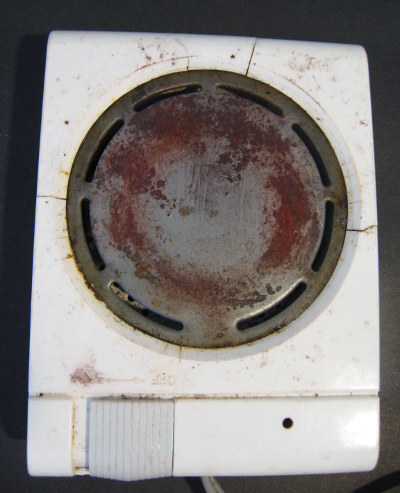
In contrast my ancient Dazey Corp mug warmer {pictured to the left} is rated at 25W and registers as 24W on the Kill-a-Watt.
We used these in lab because they would keep water in a beaker heated/warmed nicely and they didn't take up as much space as the heating/stirring mantles.
After doing a little web surfing I've discovered that Dazey Corp. went bankrupt in 1999 and these mug warmers sell on ebay for ~$50 ... I really wish I had stock piled these things *sigh*
A simple Fix
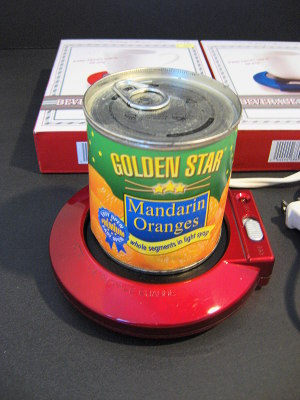
Here is a fix that I've tested and know works with the disappointingly low wattage BB&B mug warmers.
Pictured to the right is a mug warmer with a can of mandarin oranges {you can use whatever can that fits}. I then used a safety can opener to open the can so the top could be used as a lid AND removed the label since in theory it could burn.
Once that was done I used the siguie protocol.
It definitely works, on the 25g {~2 Tablespoons} scale though I doubt if it could handle much more.
The temperature of the molten xylitol remains constant at 223°F {106°C} which is just barely in the safe and still useable zone.
Just some bad pictures of the molten xylitol below.
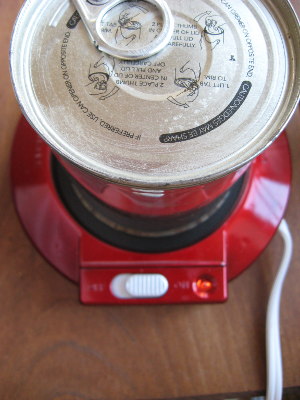
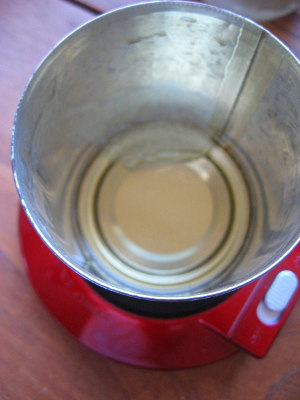
In theory the Mr.Coffee warmer will produce similar results if the wattage mentioned in an Amazon review is correct.
I of course recommend purchasing warmers from thrift stores and if possible choosing them in the 20 to 25W range.
I noticed that Target sells a 30W warmer for ~$15 shipped ... I am considering picking one up BUT "IF" it is truly 30W it may be just a little too warm and need tweaking in the other direction though on the plus side it may allow for larger scale xylitol candy production ... so stay tuned.
Microwave Xylitol Candy Making Tips
Yes, it's possible and I'm still working on a "good" reliable method. You need to be very patient and it helps to have a low power microwave AND one that cooks very very evenly. That said the best method I have found is to use a thick microwave safe ramekin {a thick mug or container will probably work too}. I use the one pictured below. It's next to the mug warmer for size comparison.
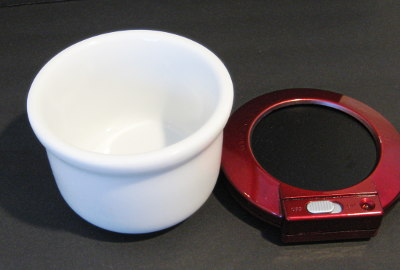
The ramekin is very thick and heavy, and I figured out it was microwaves safe by putting it in the microwave and seeing if it explodes ... if you are curious it didn't.
The trick is to preheat the ramekin to ~250°F {121°C} in a conventional oven. An infrared thermometer is really handy.Then quickly dump in your xylitol {I've done 150g this way}. Now heat in the microwave for a few seconds then stir with a dry spatula. Then back in for a few more seconds stir and repeat.
How many seconds you use will depend on your microwave and quantity of xylitol BUT I use 10 to 20 seconds to start then 5 to 10 second intervals.
Ideally you will continue doing this until all of the crystals have melted AND the liquid xylitol must never get above ~250°F {121°C}. If you see any yellow then it's Game Over and try again. However, if you succeed quickly pour into moulds and proceed as before ... oh and Congrats!
The ah hah moment for me was realizing that microwaving xylitol in a glass container, heated the xylitol but not the container, which means you are transferring heat from the xylitol to the container which is a bad way to do things. In the siguie protocol the mug warmer heats the glass first and THEN the xylitol. Preheating the container mimics that so the idea is you only need to microwave the xylitol enough to melt it and not also heat up the container.
All the normal caveats apply here, if you see yellow stop that's an impurity that will prevent or atleast mess up crystallization. Also wear good oven mitts {I use welding gloves} because you need to work very quickly before the container cools too much.
Because I have a reasonably accurate Infrared no touch thermometer I actually heat the container hotter then wait until the inside cools enough to throw in the xylitol. This gives me just a little more working time.
One thing I noticed that might interest people is that two tablespoons {~25g} completely melted in the container BEFORE microwaving. So for those just wanting to try small scale first and who do not have an acceptable mug warmer, this could be a viable option. I haven't done any additional testing so this is just an observation BUT it is an avenue to explore.
Coming Soon ... 1) where I get my xylitol 2) a quick xylitol test for purity and to make sure it's not just sucrose 3) a couple of things I can't remember ...

